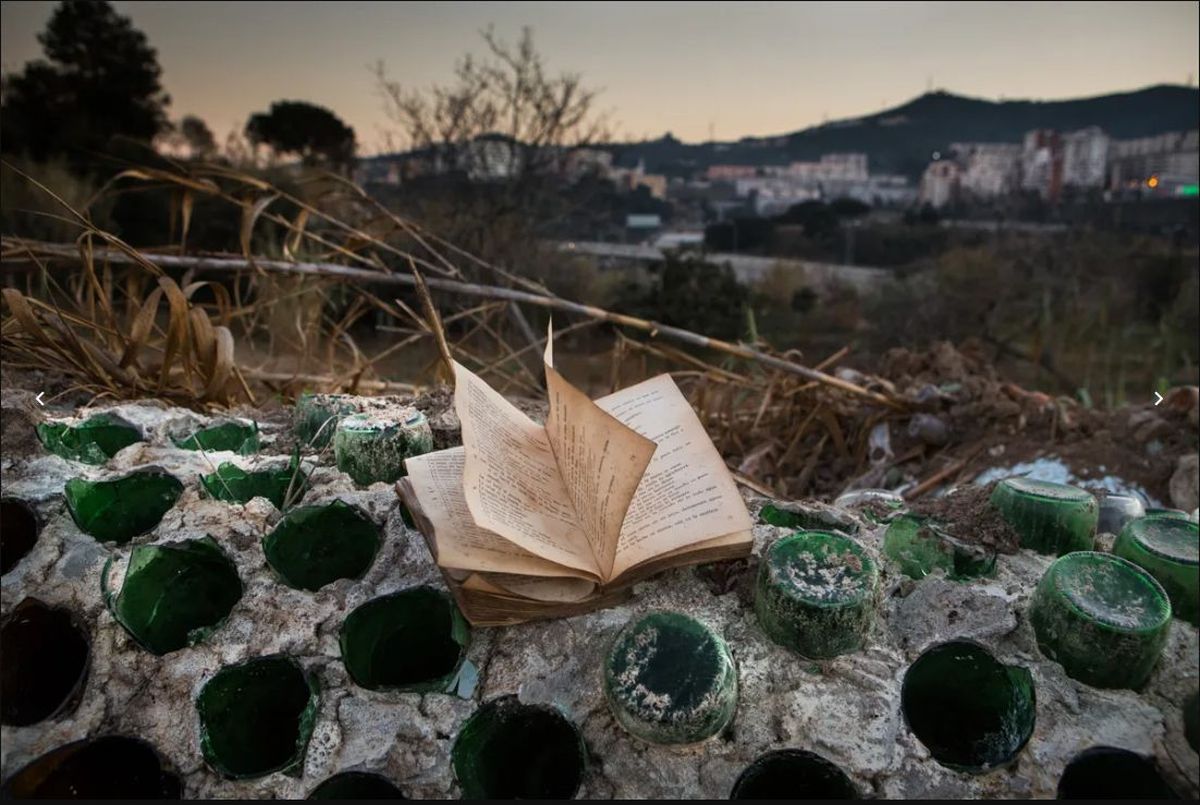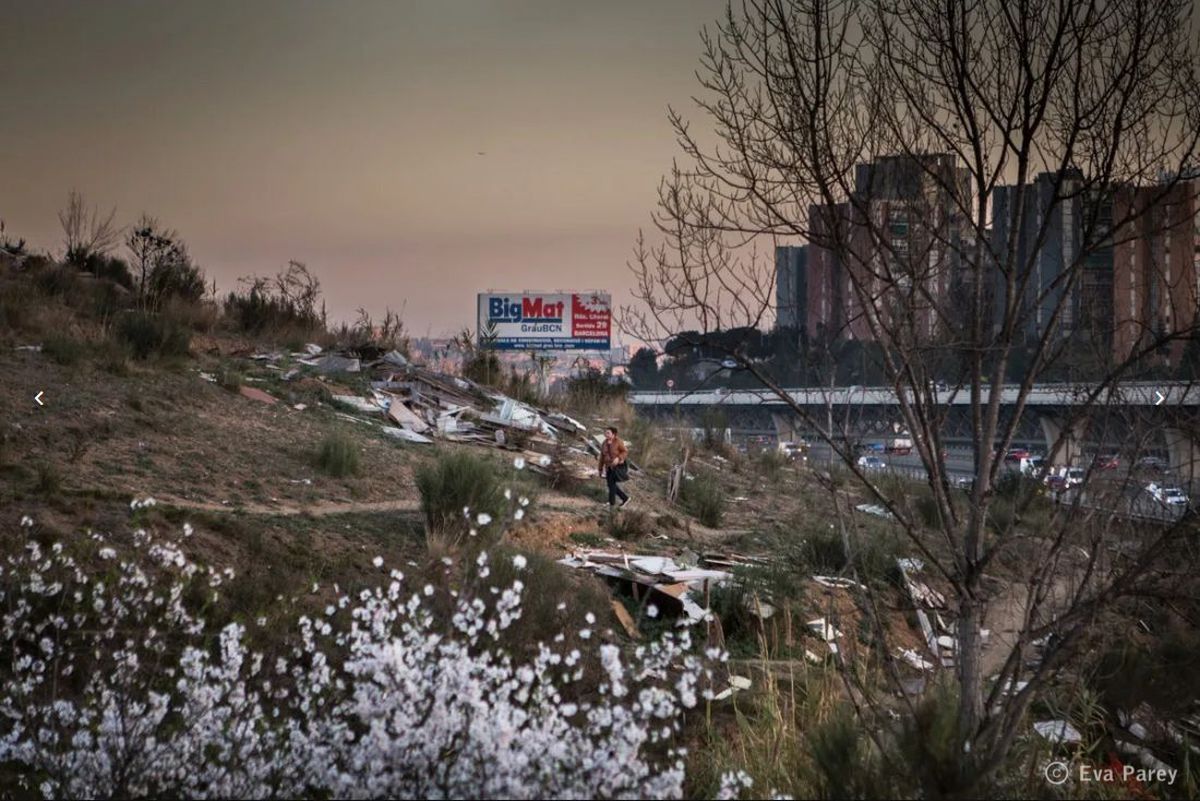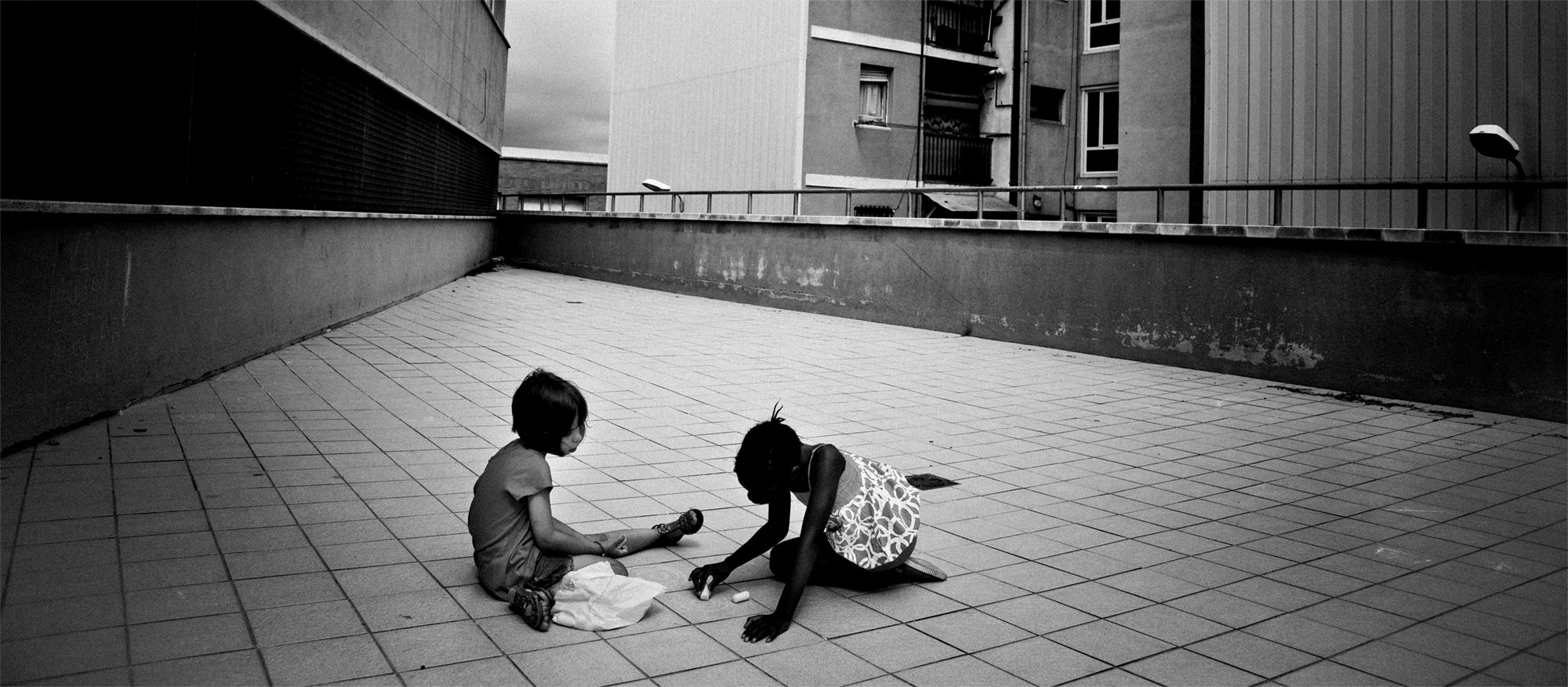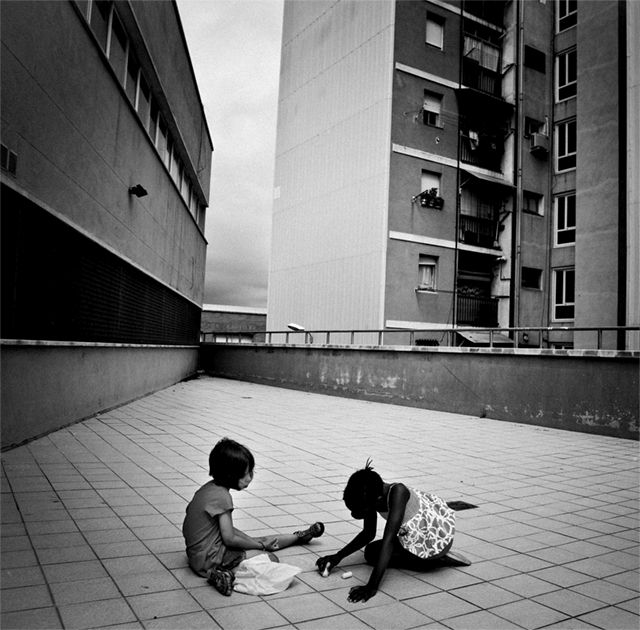Every metropolis sees how thousands of people arrive, pass through or stay. Eva Parey portrays the stories of people she comes across or that she seeks out in the streets. She has done so in Barcelona, but also in several countries in Europe and the Middle East. Babel-Barcelona, XXI is a selection of stories that Parey has uncovered over the last decade by approaching different communities.
In this Babel, living side by side are girls from Cameroon and Nigeria in Ciutat Meridiana, Pakistani women in El Raval, the gypsy community in La Mina, the homeless who she approached during the lockdown... Parey’s pictures capture the trend towards solidarity that brings together the people she depicts. They also reflect the toughness of life on the street, yet always with a glimmer of hope.

Summer refuge
The summer camp La Indomable [The Unconquerable] has been running for more than a decade in the Ciutat Meridiana neighbourhood for the children of families in precarious situations. Inseparable, Lucia and Honey (from Cameroon) play together in the summer of 2014.
© Eva Parey

Summer refuge
Yohara from the Torre Baró neighbourhood fed Angie (from Nigeria). Thanks to the 2014 summer camp many children resident in Ciutat Meridiana could avoid words such as eviction, police, poverty and prison, and could enjoy a warm experience of solidarity.
© Eva Parey

Surviving and living on the street
The young man in the picture, originally from Senegal, was carrying a refrigerator given to him by workers at a bakery on the street Carrer de Santa Anna (summer 2021). Instead of throwing it away, they let him know so he could sell it to a scrapyard. This shows that the street can be a place of solidarity among neighbours.
© Eva Parey

Surviving and living on the street
Such solidarity on the street was also experienced by the Scandinavian boys in the picture. They met and stayed together under the city wall over the strict lockdown, between March and May 2020. Other people, like them, were trapped on the street. On the one hand, the borders were closed and they could not return home, and on the other hand, they found the hostels closed or were unable to rent a room on account of people’s fear of contagion.
© Eva Parey

Veterans exposed to the elements (March-April 2020)
This young Venezuelan arrived in Barcelona in 2014 and worked as a circus artist before the lockdown. He did not want to go to a shelter set up at the Fira de Montjuïc trade fair grounds owing to his panic of crowds.
© Eva Parey

Veterans exposed to the elements (March-April 2020)
Babi and Nanda, him from Greece, and her from Cáceres, at the foot of Arc de Triomf, were able to take shelter under a large sheet of plastic given to them by a neighbourhood resident. The shelters set up by Barcelona City Council were not an option for them, since they were designated for either men or women. They did not wish to separate and took care of one another.
© Eva Parey

Trapped in limbo
Sidali, of Algerian origin with Spanish nationality, had to process his unemployment benefit following a stint working as a construction worker. Covid-19 called a halt to the processing, but he found shelter in Hall No. 7 at the Fira de Montjuïc trade fair grounds.
© Eva Parey

Trapped in limbo
In 2010, Rashid walked from Pakistan to Europe paying the mafias more than 7,000 euros. In Barcelona he kept on walking, selling soft drinks and beers. This led to his rejection by the Muslim community. Shortly afterwards he returned to his country of origin with his family.
© Eva Parey

Wisdom in a book
This book was left lying open on the ruins from late November 2015, when they demolished the house where José Cruz lived, until 27 January 2016, the day the picture was taken. José, the last inhabitant of Turó de Montcada, had moved there in 2014. He had come to Barcelona with his family in 1989, to the neighbourhood of Ciutat Meridiana. However, when he separated he went to live in the community garden in Turó de Montcada that he had bought in 1997, and then in the bottle house to prevent them from pulling it down. José read this book and always had a saying ready for every situation. “In photographing and reading this book (I didn't even touch it in situ), I discovered that it was one of José’s sources of wisdom.”
© Eva Parey

Front and last line
Hospitals, at the front line in the fight against Covid-19, and shelters, at the last line, are brimming with stories of people’s resilience. Shamaila, from Bangladesh, contracted Covid-19 during the pregnancy of her fifth child, whom she did not meet until the staff at the Hospital del Mar took her to the seafront to reunite with her husband and children after three weeks in the ICU.
© Eva Parey

Front and last line
Hospitals, at the front line in the fight against Covid-19, and shelters, at the last line, are brimming with stories of people’s resilience. Adnan, from Syria, with UN refugee status since 2018, had lived on the streets for six months with his son before being accommodated in the trade fair grounds during the lockdown. He had a deportation order to Syria from Germany. Football was his refuge while he waited to be granted asylum in Barcelona, which he obtained in November 2020. He is now fighting to bring his wife and two other children, who are in Germany, to Barcelona.
© Eva Parey

The power of education and sport
Pakistani women from the Raval neighbourhood in Barcelona and from the Sant Roc neighbourhood in Badalona were invisible neighbours in 2009. They only left home to learn Spanish in the community centre in the picture above. The classes marked a first step in gaining public space.
© Eva Parey

The power of education and sport
Pakistani girls can now study Spanish and Catalan at school in Barcelona. They have become empowered and have formed the second women’s cricket team in Spain, with the support of the Fundació per l’Esport i l’Educació de Barcelona foundation and the Centre d’Estudis Africans i Interculturals. They are being trained temporarily in the Baró de Viver neighbourhood until a pitch is fitted out in Sants-Montjuïc, after having come first in the voting stage for Barcelona City Council’s participatory budgets in 2021.
© Eva Parey

Women’s rituals
Religious beliefs are expressed through rituals and in many cases women have to celebrate them separately from men. In Barcelona’s Shiite Muslim community, women can use the mosque in Sant Adrià, as shown in the picture above, only during the celebration of Ashura. It is the commemoration of the death of Muhammad’s legitimate successor according to the Shiite community.
© Eva Parey

Women’s rituals
Religious beliefs are expressed through rituals and in many cases women have to celebrate them separately from men. This young gypsy was celebrating her ajuntamiento [coupling] at the age of 13 in the neighbourhood of La Mina in 2009. The most noteworthy ritual is the “handkerchief” test to determine the virginity of the bride. Surrounded by the community’s women, the juntaora [female specialist] verifies the existence of the hymen with a white handkerchief, and in each test she makes a knot called a rose.
© Eva Parey

The fringes of the city
The fringes become the home of those expelled from the city. Glenda, from Honduras, had just returned from cleaning a house. She lived with her husband in the Turó de Montcada shack settlement from 2014 to early 2016, in a hut they built themselves. Most of the time they were surrounded by rubble from the demolition that began in November 2014, after Turó de Montcada became part of the Collserola Natural Park as forest territory.
© Eva Parey

The fringes of the city
The fringes become the home of those expelled from the city. The shack settlement of Turó de Montcada was also the home of the boy in the picture, who was transporting petrol in drums to have some source of fuel, as the shacks were not hooked up to electricity. He was one of the settlement’s last residents.
© Eva Parey
The newsletter
Subscribe to our newsletter to keep up to date with Barcelona Metròpolis' new developments





